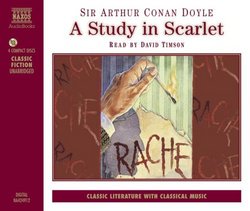| All Artists: Sir Arthur Conan Doyle, David Timson Title: Study In Scarlet Members Wishing: 0 Total Copies: 0 Label: Naxos Audio Books Release Date: 2/19/2002 Album Type: Box set Genres: Special Interest, Classical Style: Poetry, Spoken Word & Interviews Number of Discs: 1 SwapaCD Credits: 1 UPCs: 9789626342497, 730099024921, 730099024921 |
Search - Sir Arthur Conan Doyle, David Timson :: Study In Scarlet
 | Sir Arthur Conan Doyle, David Timson Study In Scarlet Genres: Special Interest, Classical |
Larger Image |
CD Details |
CD ReviewsWe are all thankful for Stamford for the wonderful introduct Austin Somlo | Vincentown, NJ | 05/24/2009 (5 out of 5 stars) "The authentic stories of the famed Sherlock Holmes are among my favorite reads, and I enjoy the adventures thoroughly. Once on my travels to London, I did visit the fictional house of Sherlock Holmes situated at 221B Baker Street. It was a surreal experience, that's for sure...because it is a fictional home of a fictional character, for goodness sake! Still to this day, I am not sure what the B part signifies: a half house or an upstairs portion? Anyway back to the story, A Study in Scarlet is the very beginning of the famous character Sherlock Holmes and his oft neglected (and still famous) sidekick Dr. John Watson. We can thank our lucky stars to Stamford for introducing both to each other before settling their claims on 221B Baker Street. From there, it began the many adventures that have encompassed the very foundation of sleuthing and solving crimes. Sir Arthur Conan Doyle introduced many of the concepts that were truly novel back and are now commonplace today among law enforcement, most notably the FBI. I find the introduction and the explanation of the techniques used by Sherlock Holmes interesting because I wondered how prevalent and how new they were at that time. Or perhaps I wondered if they were first conceived by the author in the novel, or were they just portrayed as fads at first (similar to science fiction books)? The writing by Sir Arthur Conan Doyle is very beautiful and makes A Study in Scarlet a thoroughly pleasurable read, and there is a ton of wisdom contained within the lines and especially from the dialogues of Sherlock Holmes. In the collection of quotes by Sherlock Holmes, I have in A Study in Scarlet two favorites. One is when he says, "I consider that a man's brain originally is like a little empty attic, and you have to stock it with such furniture as you choose. etc. etc." He is absolutely correct in this manner because Sherlock Holmes is very self-conscious about his knowledge being pure and away from distortions, so he can maintain a sound foundation. Another is "If I show you too much of my method of working, you will come to the conclusion that I am a very ordinary individual after all." Well, that's an interesting way of putting things. It's a bit of a complaint of mine because when I am reading the details of how Sherlock goes his business (for example, walking along the path, checking the strides, measuring the lengths, etc.) Sir Arthur Conan Doyle frequently omits the details that would allow me to make conjectures of how the crime could happen. So, what happens instead is that Sherlock Holmes will explain away the conclusions and how he arrived at them, and we, as the readers, don't get a first-hand chance to observe the actualities of the details. Anyhow, I am not going to say that it is a disappointing part of the tales, but rather it's just a pitiful block of the reader's thorough experience. In A Study in Scarlet, you will automatically, as I did, be stumped when you start reading the second part as the tale surrounds the Alkali Plain and begin to wonder if the publisher had somehow misplaced the part. Be rest assured, the tale will eventually explain the entire criminal acts that transpired in the first part of the tale. A very interesting question will appear: what if Jefferson Hope did not have an aortic aneurism, would he have been waived from his crimes because of the surrounding circumstances? Who knows? At the end of A Study in Scarlet, "Populus me sibilat, at mihi plaudo. Ipse domi simul ac nummos contemplar in arca." means "The public hisses at me, but I applaud myself in my own house, and simultaneously contemplate the money in my chest." All in all, if you want to have a totally satisfying experience of reading, you can't go wrong with A Study in Scarlet as well as other authentic Sherlock Holmes stories."
|
